Planning your holiday feast? Getting the cooking time right for your 20-pound turkey is crucial for both food safety and perfect texture. This comprehensive guide delivers precise cooking instructions based on USDA food safety standards, professional chef techniques, and years of culinary testing. You'll learn exactly how long to cook your large bird, how to properly check for doneness, and avoid the most common Thanksgiving cooking mistakes that could ruin your centerpiece dish.
Understanding Turkey Cooking Fundamentals
Cooking a 20-pound turkey isn't just about setting a timer—it's a science that depends on multiple factors including oven temperature, stuffing status, and proper thermometer use. The USDA Food Safety and Inspection Service provides clear guidelines that form the foundation of safe turkey preparation. According to their official recommendations, all poultry must reach a minimum internal temperature of 165°F to eliminate harmful bacteria like salmonella and campylobacter.
Step-by-Step Cooking Timeline for Your 20lb Turkey
Follow this professional chef-tested timeline to ensure your large turkey cooks perfectly while meeting all food safety requirements:
Preparation Phase (1-2 Hours Before Cooking)
- Thaw completely: A 20lb turkey requires approximately 4-5 days in the refrigerator (40°F or below) to thaw safely
- Bring to room temperature: Remove from refrigerator 1 hour before cooking for more even heat distribution
- Prepare stuffing (if using): Keep stuffing ingredients refrigerated until ready to use
- Preheat oven: Set to 325°F (the optimal temperature for large turkeys according to FDA guidelines)
Cooking Phase: Timing Breakdown
The cooking time for a 20-pound turkey varies based on whether it's stuffed or unstuffed. Here's the detailed timeline:
| Turkey Size | Unstuffed Cooking Time | Stuffed Cooking Time | Recommended Oven Temp |
|---|---|---|---|
| 20 pounds | 4 hours 20 minutes | 4 hours 45 minutes | 325°F |
| Per pound guideline | 13 minutes/lb | 15 minutes/lb | 325°F |
This data aligns with the USDA's Food Safety and Inspection Service recommendations, which state that larger turkeys require lower temperatures for longer periods to ensure even cooking without drying out the exterior before the interior reaches safe temperatures. The 325°F setting represents the current standard that has evolved from higher temperature recommendations used decades ago.
Essential Monitoring During Cooking
Set timers for these critical checkpoints during your turkey's cooking process:
- After 3 hours: Check initial internal temperature in the breast (should be around 110-120°F)
- Every 30 minutes thereafter: Monitor temperature progression
- When breast reaches 150°F: Begin checking thigh temperature more frequently
- Final check: Confirm both breast and thigh reach 165°F in multiple locations

Contextual Factors That Affect Cooking Time
While the standard calculation provides a reliable starting point, these variables can significantly impact your actual cooking time:
- Oven accuracy: Most home ovens vary by 15-25°F from the set temperature—use an independent oven thermometer
- Roasting pan type: Dark metal pans cook faster than glass or ceramic
- Basting frequency: Opening the oven door adds 5-10 minutes per occurrence to total cooking time
- Initial turkey temperature: A turkey straight from the refrigerator takes longer than one brought to room temperature
- Convection vs. conventional: Convection ovens reduce cooking time by approximately 25%
Post-Cooking Essentials: Resting and Carving
Many home cooks make the critical mistake of carving immediately after removing the turkey from the oven. Proper resting is essential for moisture retention:
- Resting time: Minimum 30-45 minutes for a 20lb turkey
- Temperature rise: Internal temperature will continue rising 5-10°F during resting (carryover cooking)
- Carving preparation: Tent loosely with foil during resting to maintain warmth without steaming the skin
- Final safety check: Verify internal temperature remains at or above 165°F before serving
Common Mistakes That Extend Cooking Time
Avoid these frequent errors that can add significant time to your turkey preparation:
- Opening the oven too frequently: Each peek adds 5-10 minutes to cooking time
- Incorrect thermometer placement: Inserting too close to bone gives false high readings
- Stuffing the turkey too tightly: Creates air pockets that slow heat transfer
- Starting with a partially frozen bird: Adds up to 50% more cooking time
- Using an inaccurate oven thermometer: Most built-in oven thermometers are unreliable
Food Safety Timeline Evolution
Turkey cooking recommendations have evolved significantly based on improved food safety research:
- 1950s-1970s: Recommended cooking to 180°F, resulting in consistently dry meat
- 1980s-1990s: Temperature lowered to 170°F as thermometer technology improved
- 2000s: USDA established 165°F as the safe minimum based on pathogen research
- 2011: Introduction of real-time temperature monitoring guidelines
- Present: Emphasis on precise temperature zones and carryover cooking principles
This evolution reflects better understanding of food science and pathogen behavior. The current 165°F standard represents the minimum temperature at which harmful bacteria are eliminated instantly, according to the USDA Food Safety and Inspection Service.
Troubleshooting Common Cooking Issues
When your turkey isn't progressing as expected, these solutions can help:
- Breast cooking faster than thigh: Tent breast with foil to slow cooking while thigh catches up
- Turkey browning too quickly: Reduce oven temperature by 25°F and cover with parchment paper
- Internal temperature stalled at 140°F: This "plateau" is normal—continue cooking patiently
- Stuffing not reaching 165°F: Transfer to separate dish and bake until safe temperature is reached
- Turkey finished early: Keep warm by tenting with foil in a 140°F oven (never hold below 140°F for food safety)
Proven Techniques for Perfect Results
Professional chefs use these methods to ensure flawless large turkey preparation:
- Dry brining: Salt the turkey 2-3 days in advance for enhanced moisture retention
- Butter under skin: Creates a protective layer that bastes the meat from within
- Vertical roasting: For more even cooking and crispier skin on large birds
- Temperature zoning: Place turkey breast-side down for first hour, then rotate
- Thermometer alarms: Use wireless probes to monitor multiple temperature points simultaneously
Frequently Asked Questions
Here are answers to the most common questions about cooking large turkeys:
Can I cook a 20lb turkey at 350°F instead of 325°F?
Yes, but you'll need to adjust the time. At 350°F, a 20lb unstuffed turkey requires approximately 4 hours total. Higher temperatures cook the exterior faster, increasing the risk of dry breast meat before the thigh reaches safe temperature. The USDA recommends 325°F as the optimal temperature for even cooking of large turkeys.
How do I know when my stuffed 20lb turkey is done?
Check both the turkey and stuffing temperatures. The turkey is done when the breast reaches 165°F and the thigh reaches 170-175°F. The stuffing must also reach 165°F in its center. Never rely on pop-up timers as they often activate before the thigh reaches safe temperature. Use an instant-read thermometer in multiple locations for accuracy.
Why does my 20lb turkey take longer to cook than the estimated time?
Several factors can extend cooking time: an oven running cooler than set temperature, starting with a partially frozen turkey, frequent oven door openings, or using a glass/ceramic roasting pan instead of metal. Always verify with an independent oven thermometer and check internal temperature rather than relying solely on time estimates.
Should I cover my 20lb turkey with foil while cooking?
Covering with foil can be beneficial in specific situations. If the breast is browning too quickly (after the first 2-3 hours), tent loosely with foil to prevent over-browning while allowing heat circulation. Never cover the entire turkey for the full cooking time as this creates steaming conditions that prevent crispy skin. Remove any foil during the last 45-60 minutes for proper browning.
How long should a 20lb turkey rest before carving?
A 20lb turkey needs 30-45 minutes of resting time. This allows the muscle fibers to relax and reabsorb juices that would otherwise run out when carving. Tent loosely with foil during resting to maintain warmth without creating steam that would soften the skin. Proper resting ensures moist, tender meat throughout the bird rather than dry slices.











 浙公网安备
33010002000092号
浙公网安备
33010002000092号 浙B2-20120091-4
浙B2-20120091-4